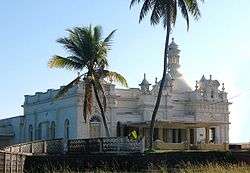Beruwala
Beruwala (Sinhala:බේරුවල Tamil: பேருவளை ) is a town in Kalutara District, Western Province, Sri Lanka, governed by an Urban Council. Beruwala with a total area of approximately 15 square kilometres and is located on the south-west coast of Sri Lanka, 60 km (37 mi) south of Colombo.[1]
Beruwala බේරුවල பேருவளை | |
|---|---|
Town | |
 Kechchimalai Mosque, Beruwala (one of the oldest mosques in Sri Lanka) | |
 Beruwala Location in Sri Lanka | |
| Coordinates: 6°28′N 79°59′E | |
| Country | Sri Lanka |
| Province | Western Province |
| District | Kalutara District |
| Government | |
| • Type | Urban Council |
| • Chairman | Masahim Mohamed |
| Population (2012) | |
| • Total | 34,256 |
| Time zone | UTC+5:30 (Sri Lanka Time) |
| Area code(s) | 034 |
Etymology
The name Beruwala is derived from the Sinhalese word for the place where the sail is lowered. It marks the spot for the first Muslim settlement on the island, established by the Somali Sheikh Yusuf bin Ahmad al-Kawneyn, who converted the people into Islam. The town was originally named Berbereen in honour and respect of the Somali Shaikh. [2] The Chinese also traded here and Beruwala was known to them as Piehlo-li.[3]
History
Beruwala has the first recorded Muslim settlement in Sri Lanka, with records establishing the settlement by Arab traders around the 12th century AD.
Yusuf bin Ahmad al-Kawneyn is also credited with establishing the first Sri Lankan Muslim settlement. Which marks the spot for the first Muslim settlement on the island, established by the Somali Sheikh Yusuf bin Ahmad al-Kawneyn, .[4][5]
A large population of Sri Lankan Moors, many of them are gem merchants, still live in the town, particularly in the China Fort and Maradana areas.
Demographics
Beruwala is a Moor majority town; there are sizable communities belonging to other ethnic groups, such as Sinhalese and Tamils
| Ethnicity | Population | % Of Total |
|---|---|---|
| Moors | 25,177 | 75.85 |
| Sinhalese | 7,199 | 10.67 |
| Sri Lankan Tamils | 410 | 2.00 |
| Indian Tamils | 249 | 1.00 |
| Other (including Burgher, Malay) | 18 | 0.01 |
| Total | 33,053 | 100 |
Source:statistics.gov.lk
Attractions
- Beruwala has a large population of Sri Lankan Moors, many of them gem merchants, who still live in the town particularly in the China Fort and Maradana area.
- Ketchchimalai Mosque situated in Maradana is a significant landmark of the town and one of Sri Lanka's oldest mosques. It was constructed by Arab traders on a rocky peninsula overlooking the town.
- Galapata Temple - a Buddhist temple built in the 12th Century.
- Masjid Al Abrar situated in Maradana is the first Muslim Mosque of Sri Lanka built in 920 AD presumably by Arab traders who frequented Sri Lanka by sea.
Transport
Road
Beruwala is served by the A2 highway, which runs past the town.
Education
Beruwala is home to Al-Fasiyatul Nasriya Muslim Balika Navodaya School Maradana, which is the first and oldest Islamic girls school in Sri Lanka. It was damaged by the tsunami on Boxing Day 2004.
Government schools
- Al Fasiyathul Nasriya Ladies (Navodaya) College
- Naleem Hajiar Ladies College (Navodaya)
- Al Humaisara National School (boys)
- ZAM Refai Hajiar Maha Vidhyala
- ILM Samsudeen Maha Vidhyala
- DS Senanayake National School
- Ariyawansha Maha Vidyala
- Al Fasiyathul Nasriya Boys School
International schools
- Harrow International School
- Wisdom International School
- Golden Gate International School
University and colleges
- Jamiah Naleemiah Islamic University (1973) Founder - Al Hajj Marhoom Naleem
- Iqra Technical College Founder - Al Hajj Marhoom Naleem
International relations
See also
References
- Secretariat of the Convention on Biological Diversity (2007). Managing tourism & biodiversity: user's manual on the CBD guidelines on biodiversity and tourism development. Secretariat of the Convention on Biological Diversity. p. 63.
- Jaleel, Talib (8 July 2015). Notes On Entering Deen Completely: Islam as its followers know it. EDC Foundation. p. 1106.
- "Journal of the Sri Lanka Branch of the Royal Asiatic Society". 30-32. Sri Lanka Branch of the Royal Asiatic Society. 1985: 78. Cite journal requires
|journal=(help) - Galaal, Musa (1980). "Les liens historiques entre la corne de l'Afrique et les îles du golfe Persique et de l'océan Indien par les voies de l'Islam". Relations historiques à travers l'océan Indien. Belgique: l'Organisation des Nations Unies pour l'éducation, la science et la culture. p. 28. ISBN 978-92-3-201740-6.
Translated from French to English: Now this holy man - this is the new point (Al Kownayn) – seems to be the same as that which the people of the Maldive Islands, near India, called Barakath Al-Barbari who spread Islam in this region as he did in the Horn of Africa. We only know in which of these two regions he lived first and this prompted him to change sectors of business.The tomb of Sheik Barkhadle (Yusuf Al Kownayn) is in a ruined city called Dhogor, near Hargeisa, in the north of the Democratic Republic of Somalia.
- Honchell, Stephanie (2018), Sufis, Sea Monsters, and Miraculous Circumcisions: Comparative Conversion Narratives and Popular Memories of Islamization, Fairleigh Dickinson University and the University of Cape Town, p. 5,
In reference to Ibn Batuta's Moroccan theory of this figure, citation 8 of this text mentions, that other accounts identify Yusuf Al Barbari as East African or Persian. But as a fellow Maghribi, Ibn Battuta likely felt partial to the Moroccan version.
- "Reading - Town Twinning". Reading Borough Council. Archived from the original on 2013-05-09. Retrieved 2013-07-14.